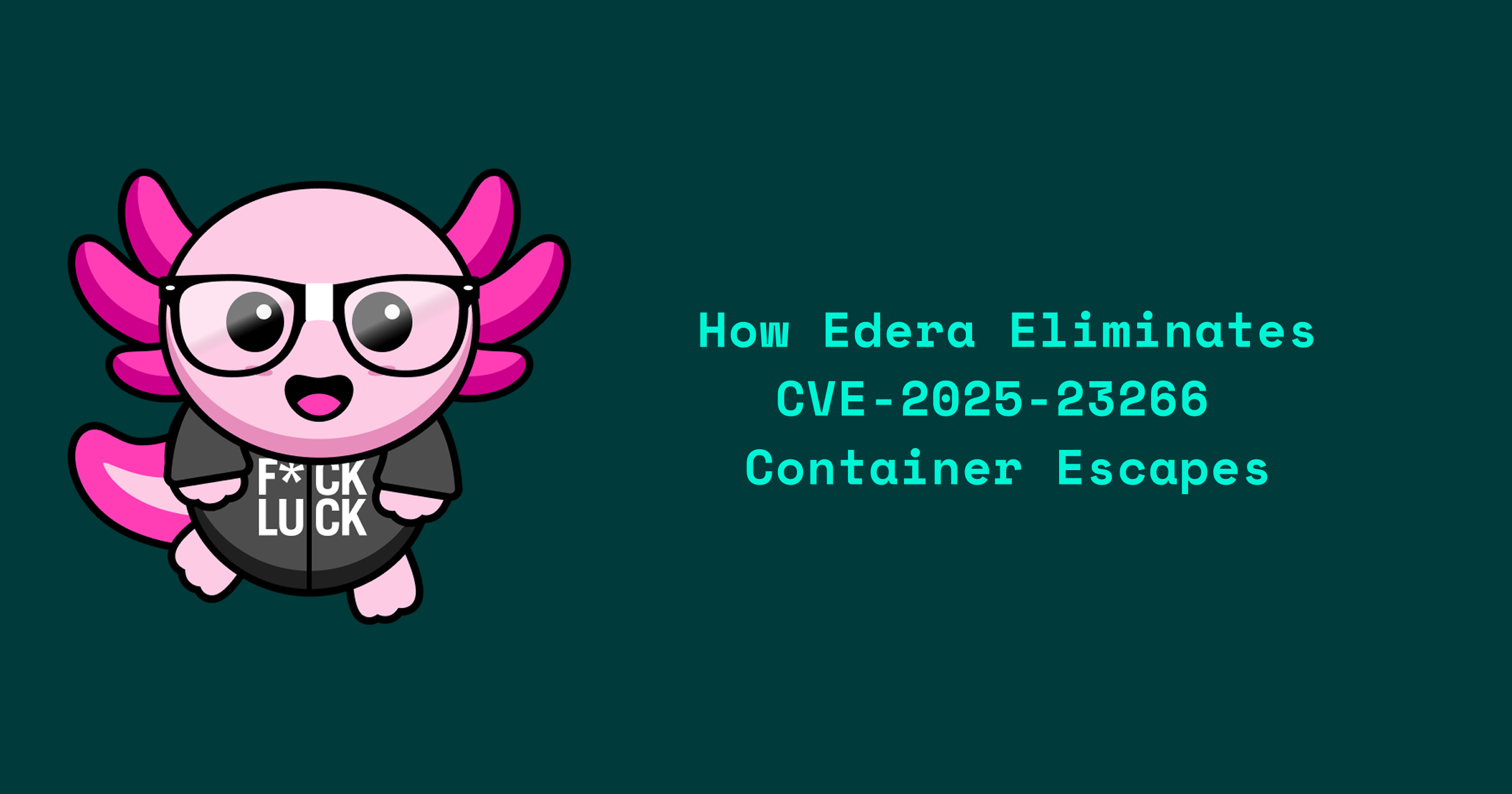How Edera Eliminates CVE-2025-23266 Container Escapes
Tl;dr: Edera's hardened runtime technology would have completely prevented the CVE-2025-23266 NVIDIA Container Toolkit vulnerability by eliminating the shared kernel state that makes this container escape possible.
CVE-2025-23266: NVIDIA Container Escape Explained: A Simple Three-Line Attack
CVE-2025-23266, discovered by researchers at Wiz, is a critical container escape vulnerability (CVSS 9.0) in the NVIDIA Container Toolkit that can be exploited with a simple three-line Dockerfile. The vulnerability stems from a subtle misconfiguration in how the toolkit handles OCI hooks, allowing attackers to achieve full host compromise through environment variable manipulation.
The attack works because createContainer hooks inherit environment variables from the container image and execute with privileged access on the host. By setting LD_PRELOAD in their Dockerfile, attackers can force the nvidia-ctk hook to load a malicious library, escaping container boundaries entirely.
The root issue is that the container shares the host kernel and the privileged hooks execute within that shared context, allowing environment variable manipulation to affect host processes.
.jpeg)
Organizations can immediately protect against CVE-2025-23266 by upgrading to NVIDIA Container Toolkit v1.17.8+ or GPU Operator v25.3.1+. For long-term security against this class of vulnerabilities, consider Edera's hypervisor-based container isolation.
How Edera Stops CVE-2025-23266 Exploits
Edera eliminates the entire attack surface through true isolation:
Hypervisor-Level Isolation Edera isolates containers into zones, Edera’s production-grade sandbox, with each zone containing its own guest operating system. This eliminates the shared kernel used by traditional container isolation. Each container runs in its own isolated kernel, creating complete workload isolation.
No Shared Kernel State Instead of running containers in Linux namespaces, Edera's platform treats a container like a virtual machine guest. There is no shared kernel state between containers, and a memory-safe Rust control plane further secures workloads.
.jpeg)
With Edera's approach:
- Isolation Boundary: The container would run in its own zone with a separate guest OS kernel
- Hook Execution Context: Any NVIDIA toolkit hooks would execute within the isolated guest environment, not on the host
- No Privilege Escalation Path: Even if
LD_PRELOADwere set, it would only affect processes within the isolated guest, not the host system
Beyond CVE-2025-23266: Edera’s Security Advantages
Edera is compatible with existing OCI images and complies with the Kubernetes CRI specification for seamless use by existing systems. This reduces barriers to use by ensuring existing applications can run in Edera without modification. This means organizations could have adopted Edera's protection without changing their existing container workflows.
The approach prevents lateral movement and ensures workload sanctity, with protection at a technical layer low enough to stop container escapes.
Furthermore, Edera handles GPU access natively, eliminating the need for the use of the NVIDIA Container Toolkit in the first place. By removing the dependency of the NCT, you are reducing your attack surface and protecting yourself from vulnerabilities like this one.
Architectural Security Matters: Lessons From CVE-2025-23266
This research highlights that containers are not a strong security barrier and should not be relied upon as the sole means of isolation. Organizations should implement at least one strong isolation barrier, such as virtualization, especially in multi-tenant environments.
CVE-2025-23266 perfectly demonstrates why architectural security choices matter. While traditional container security relies on patching individual vulnerabilities as they're discovered, Edera's hypervisor approach provides proactive protection against entire classes of attacks.
FAQ: CVE-2025-23266 and Container Isolation
What is CVE-2025-23266?
CVE-2025-23266 is a critical container escape vulnerability in the NVIDIA Container Toolkit that allows attackers to execute arbitrary code on the host system.
How does CVE-2025-23266 work?
It exploits how the container toolkit inherits environment variables, allowing malicious LD_PRELOAD values to trigger privileged hooks on the host.
How can organizations protect against CVE-2025-23266?
Update to the latest NVIDIA toolkit (v1.17.8+), or eliminate shared kernel dependencies with hypervisor-based isolation like Edera.
Why isn’t traditional container security enough?
Containers share the host kernel, making them vulnerable to privilege escalation and container escapes unless isolated at the hypervisor level.

-3.png)